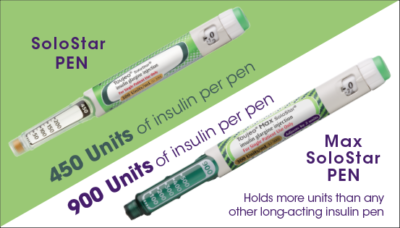Insulin Glargine is a long-acting basal insulin used to treat diabetes patients. It is available in three concentrations i.e. U-100 (Lantus), U-300 (Toujeo), and U-500 (Toujeo Max). U-100 means 100 units per ml; U-300 means 300 units per ml; and U-500 means 500 units per ml.
This means that U-100 is 3 & 5 times less concentrated than U-300 & U-500. Thus to inject the same dose more volume of U-100 insulin will be required than U-300 and U-500. The U-300 and U-500 insulins are prepared for those patients who require a higher dose.
It has been studied in patients with cardiovascular diseases and has been found to have a neutral effect on cardiovascular outcomes. Compared to short and intermediate-acting insulin, Insulin Glargine has been found to have reduced rates of hypoglycemic episodes.
However, in both Type 1 and Type 2 Diabetes Mellitus, Glargine insulin was more associated with hypoglycemic events when compared to Insulin Degludec [Ref 1 & Ref 2]
Insulin Glargine Vs Regular Insulin in Surgical patients:
Surgical patients are usually administered parenteral nutrition. Dextrose is one of the components of Parenteral nutrition. Diabetic surgical patients are therefore difficult to manage pre and post-operatively.
One study compared Glargine Insulin with Regular insulin. The study concluded that patients who were administered regular insulin had better glycemic control and the risks of hypoglycemia were equivalent in both groups [Ref].
Insulin Glargine U-100 vs U-300 (Lantus vs Toujeo):
Insulin Glargine (U-100) |
Insulin Glargine (U-300) |
|
| Brand Names | Lantus | Toujeo |
| Concentration | 100 units per ml | 300 units per ml |
| Duration of action | Up to 24 hours | More than 24 hours |
| Onset of action | 3 – 4 hours | 6 hours |
| Timings of administration | Should be administered at a fixed time daily | Slight flexibility in dose administration (up to 4 hours) |
Insulin Glargine Vs Insulin Degludec:
Insulin Glargine |
Insulin Degludec |
|
| Brand Names | Lantus, Toujeo | Tresiba |
| Concentration (Each pen has 3 ml insulin) |
|
|
| Duration of action | Up to 24 hours | Up to 36 hours |
| Onset of action | 3 – 4 hours | One hour |
| Timings of administration | Should be administered at a fixed time daily | May be administered at any time of the day. |
Dose in Adults
Insulin glargine dosing is based on individuals' blood sugar levels. Therefore, for adequate control, frequent monitoring of blood glucose is important.
Initial Insulin Glargine dosing in Type 1 Diabetes Mellitus:
Basal insulin like Lantus should be initiated at a lower dose i.e. 0.2 - 0.4 Unit/Kg to avoid the risk of hypoglycemia.
Higher doses i.e. 0.4 - 0.5 Unit/kg may be considered in patients who are obese, have a sedentary lifestyle, and dose in Diabetic ketoacidosis.
Usual maintenance dose:
- 0.4 - 1 unit/kg/day once daily or in two divided doses.
- Glargine Insulin is usually given in combination with short or rapid-acting insulins.
- The short-acting (Regular insulin) and the Rapid-acting insulins (Aspart, glulisine, and Lispro) are administered before each meal to cover post-meal hyperglycemia.
- The insulin glargine dose is adjusted twice or thrice weekly to prevent hypoglycemia. Patients requiring high doses may be given insulin glargine in two divided doses.
Insulin Glargine in Type 2 Diabetes Mellitus:
- Basal Insulin should be initiated in patients who do not achieve their glycemic targets. Glargine Insulin is initiated in combination with metformin and other oral agents.
- The ADA (American Diabetes Association) recommends insulin as a part of the regimen in patients who have glycated hemoglobin of more than 10%, blood sugars of more than 300 mg/dl, and those patients who are persistently symptomatic despite treatment [Ref].
- In patients who are reluctant to go on insulin and those patients who are at risk of hypoglycemia, basal insulins like Glargine and Detemir may be preferable.
Insulin glargine dose in Type 2 Diabetes patients:
- The manufacturer recommends a starting dose of 10 units or 0.1 - 0.2 Units/Kg/day once daily.
- According to the ACE/AACE recommendations, patients with glycated hemoglobin of more than 8% should be started on 0.2 - 0.3 Units/kg/day.
Glargine Dose adjustment:
- Patients should increase the insulin dose by 2 - 4 units or 10% - 20% of the dose twice or thrice weekly to achieve the target blood sugars.
- If the patient develops hypoglycemia, the dose should be decreased by 4 units or 10% - 20% of the dose
Glargine Insulin dose adjustment in patients on enteral feeding:
- 10 units or 30 - 50% of the total required dose should be given as basal insulin while the rest of the insulin is given as a bolus (short or rapid-acting) insulin into three or four divided doses
Glargine in patients undergoing surgery:
- The dose of basal insulin (insulin glargine, detemir, or Degludec) should be reduced to 60% - 80% of the total daily dose.
How to adjust the dose when switching from NPH insulin:
- Patients on once-daily NPH insulin should be advised the same dose of insulin glargine.
- Patients on twice-daily NPH insulin should be advised to reduce the dose of glargine by 20% and administer as once daily.
Dose adjustment when switching from Toujeo to Lantus and vice versa:
- When switching from Lantus to Toujeo, the same dose should be used. However, the dose should be reduced by 20% when switching from Toujeo to Lantus.
Conversion from Toujeo Solostar to Toujeo Max Solostar:
The same dose should be used, however, the dose should be an even number.
Glargine Use in Children:
Glargine Insulin is long-acting insulin and equally potent as human insulin. The dose should be individualized based on the child's physical activity, body weight, eating habits, and renal and liver reserves.
Since Glargine has no peak, it is less likely than NPH insulin to cause hypoglycemia. Thus, Glargine, Detemir, or Degludec may be preferable for children.
Note: All children with Type 1 Diabetes Mellitus should receive short-acting or rapid-acting insulin in combination with basal insulin.
Glargine Dose in Children:
- Basal insulin in children should make up a third of the total daily insulin dose. Rapid and short-acting insulins in divided doses should make the rest 2/3rd.
- When switching from once-daily NPH to Lantus (glargine), the same dose should be used. However, the dose should be reduced by 20% when switching from twice-daily NPH insulin to once-daily glargine.
Patients undergoing surgery:
- The dose of basal insulin (Glargine, Detemir, or Degludec) should be reduced to 60% - 80% of the total daily dose.
- Ideally, patients should be scheduled for early in the morning for surgery. The morning dose of premeal insulin should be omitted. Patients should be started on Insulin and glucose infusion prior to surgery.
Pregnancy Risk Factor C
- Maternal hyperglycemia can lead to adverse drug reactions in mothers, neonates, and babies.
- Congenital malformations can also be caused by maternal hyperglycemia.
- Insulin requirements decrease during the first trimester, rise after 28 weeks gestation and then drop after birth [ Ref].
- Glargine Insulin is highly sensitive to the Insulin-like growth factor. This could theoretically increase the risk of having adverse pregnancy outcomes.
- These effects have not been proven by studies. Women with stable glycemic control may continue to use insulin.
- Patients who have just started insulin therapy should not be advised of Glargine insulin.
Use for Breastfeeding
- Insulin glargine has been labeled compatible with breastfeeding by the manufacturer.
- Breast milk contains insulin (exogenous and endogenous). To avoid hypoglycemia during lactation, reduce the dose.
Insulin Glargine (Lantus/ Toujeo) use in Kidney impairment:
- The manufacturer does not recommend any dose adjustment in renal disease.
- However, the dose should be reduced as renal excretion of insulin is impaired.
Insulin Glargine (Lantus/ Toujeo) use in Hepatic impairment:
- The dose should be adjusted as glucose and insulin metabolism is affected in patients with liver disease.
Insulin Glargine Side Effects (Common):
- Hypoglycemia,
- hypertension,
- edema,
- depression,
- flu,
- infections,
- arthralgia,
- skeletal pains,
- cataract,
- retinopathy,
- respiratory and urinary tract infections, and
- the development of antibodies.
Less common side effects of Insulin Glargine:
- Pain at the injection site, headache,
- retinal vascular disease,
- pharyngitis,
- rhinitis,
- erythema,
- swelling and edema at the injection site, and
- angioedema.
Insulin Glargine Contraindications:
- Hypoglycemia and allergy to insulin or any component of it.
Insulin Glargine Warnings and Precautions:
- Hypoglycemia can be caused by insulin. You should adjust the dose according to your blood sugar levels. Hypoglycemia can be caused by an increase in insulin glargine dose daily.
- Patients on insulin may experience hypokalemia due to intracellular potassium shifts. Hypokalemia can cause serious cardiac arrhythmias. It should not be used for Diabetic Ketoacidosis.
- It should not be injected intramuscularly or intravenously. It is intended only for subcutaneous application.
Monitoring Parameters:
- At regular intervals, monitor the patient's blood sugars and glycated hemoglobin.
- Before initiating therapy, it is important to monitor the liver and renal functions.
- Premeal blood sugars must be maintained between 70 and 130 mg/dl. Postprandial blood sugars shouldn't exceed 180 mg/dl.
- Glycated hemoglobin should not exceed 7% for most patients. However, this should be determined individually.
How to administer Insulin Glargine?
- This product is only intended for subcutaneous application.
- Clear solutions should only be used for subcutaneous use.
- It is not recommended to administer the injection immediately after removing it from the refrigerator.
- You should inject it in your abdomen or thighs daily.
- To avoid lipodystrophy, the injection site should be rotated.
- You should not mix or dilute it with any other insulins.
- Pen-filled syringes allow for injections of up to 80 units in a single dose (Lantus or Toujeo) and 160 units in a single dose (Toujeo Max SoloStar). Only use cartridges with reusable pens
Insulin Glargine Mode of Action:
- Insulin regulates the metabolism of carbohydrates, fats, and proteins.
- Insulin stimulates the production of glycogen and fatty acids in the liver.
- It stimulates protein synthesis in the skeletal muscles and increases glycogen synthesis.
- It stimulates triglyceride production and processes lipoproteins for free fatty acids.
- It stimulates the cellular metabolism of proteins and increases potassium uptake in cells through the activation of sodium-potassium ATPases.
- Recombinant DNA technology is used to make insulin products using Saccharomyces cerevisiae or E.coli.
The onset of action of glargine Insulin:
- Lantus: 3 to 4 hours
- Toujeo: 6 hours
The site of injection will depend on how large and concentrated the injection is, what preparation was used, exercise, lipodystrophy, temperature, local blood supply, and the location of the injection. Subcutaneous injections into the arm, abdomen, and buttocks are slower.
Peak effect:
- Lantus, Basaglar: No peak; Toujeo: The maximum glucose-lowering effect may take up to five days with repeat dosing.
- The 24-hour glucose-lowering effect is 27% lower than that of Lantus at the same doses.
Duration of action:
- Lantus, Basaglar: 10.8 to 24 (up to 30 hours)
- Toujeo: more than 24 hours
Excretion: Urine
Insulin Glargine Brand Names (international):
- Abasaglar
- Abasria
- Basagine
- Basaglar
- Basaglar KwikPen
- Basalog
- Basalog One
- Bonglixan
- Endulin
- Ezelin
- Glargilin
- Glaritus
- Glysolin G
- Insulet GN
- Lantus
- Lantus XR
- Lusduna
- Optisulin
- Podevta
- Sansulin Log-G
- Toujeo
- Tuojeo
- Vibrenta
Insulin Glargine Brand Names in Pakistan:
- Basaline
- Basagine
- Lantus optiset
- Lantus solostar
- Meritus
"Lantus Asaan" Program launched by Sanofi Aventis:
Sanofi Aventis has launched a program by the name of "Lantus Asaan" in Pakistan. This program is for non-affording patients. Insulin Lantus Solostar is delivered to the patients at a discounted price by the company. Discount Cards are given to the patients and it is delivered at home at 40% less price than the market price.




